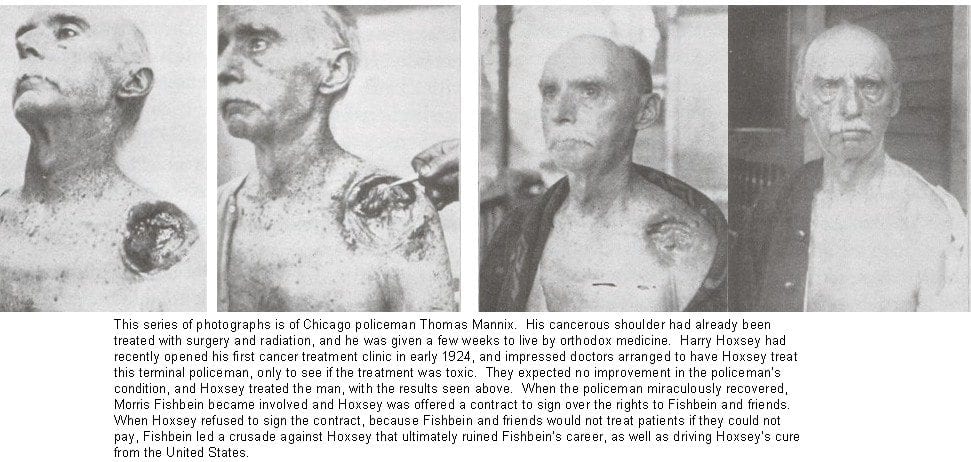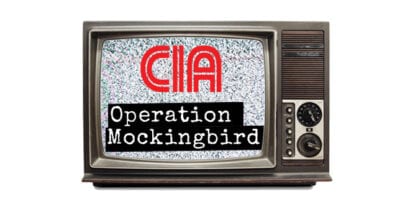It’s rare that a person who introduces a successful alternative cancer cure fights back continuously against the medical establishment’s cancer industry while remaining in the USA with any success. Yet the colorful and dynamic Harry Hoxsey did so often for over 35 years and won a few battles in the process. The medical establishment used the FDA to eventually win the war. His USA operations were closed down in 1960, but his legacy continues as the Bio-Medical Center in Tijuana, Mexico. His clinic was the first alternative cancer clinic to flee into a less politically medical hostile environment. Others have since followed, thanks to the tyrannical monopoly of the Medical Mafia.
The Hoxsey Clinic’s Approach
 There are two herbal formulas used in the Hoxsey treatment. One is external, and it consists of a red paste made with bloodroot, the active anti tumor ingredient, mixed with zinc chloride and antimony sulfide. This paste is applied directly onto skin cancer tumors.
There are two herbal formulas used in the Hoxsey treatment. One is external, and it consists of a red paste made with bloodroot, the active anti tumor ingredient, mixed with zinc chloride and antimony sulfide. This paste is applied directly onto skin cancer tumors.
The internal tonic consists of Red Clover blossom, Licorice root, Buckthorn bark, Burdock root, Stillingia root, Poke root, Barberry root, Oregon Grape root, Cascara Sagrada bark, Prickly Ash bark, Wild Indigo root and Sea Kelp. The Sea Kelp may have been added more recently to the original formula. A supplement of potassium iodide was included along with the tonic.
In the clinic, patients eat together and mingle freely among themselves. The atmosphere is cordial and friendly, the type of positive attitude that encourages healing, sometimes in and of itself. Communication among staff and patients is open. Humor and positive attitudes are encouraged. When Hoxsey was in charge, he would personally greet and encourage patients to instill a positive attitude.
There was, and still is a one time fee, which enables patients to return as often as needed and receive the tonics. In 2005 at the now renamed Mexico Bio-Medical Center, it was around $3500 to $5000 with a one-third down payment. Compare that to chemotherapy, surgery, radiation, doctor bills, and hospital stays for the average cancer patient!
Hoxsey himself never turned anyone down for lack of funds. He had become successful as an oil man in Texas and he didn’t need the money. Yet claims that Hoxsey was a con man out to exploit people anxious for a cure was a chronic AMA tactic.
Journalist James Burke observed Hoxsey take people who had traveled to his clinic in Dallas and personally handle all their travel and living expenses while charging nothing if they were broke. Burke was originally sent by Esquire Magazine in 1939 to expose Hoxsey as a quack and a fraud.
After witnessing so many patients recover, the manner in which they were treated, and the generosity Hoxsey displayed for cancer victims low on cash, Burke submitted an article titled “The Quack Who Cures Cancer” to Esquire Magazine. It didn’t get printed. After WW II, James Burke worked for Hoxsey as a press agent.
All the medical institutional queries into Hoxsey’s treatments were and still are negative and dismissive. And these reports are the ones that get published and circulated among the medical journals and press releases to the mass media.
What doesn’t get circulated in journals or mass media, however, is that several independent doctors, free of association or institutional restraints, conducted their own investigations and concluded that the Hoxsey therapy was more effective at curing cancer than the “conventional methods,” and without side effects. Additionally, there are many Hoxsey cured patient testimonials.
Hoxsey’s Personal History and Battles with the Medical Mafia
Harry Hoxsey was not a medical practitioner. But he was the young son of a rural Illinois veterinarian who used an herbal tonic and salve on animals, mostly horses, then secretly on humans with cancer. He found the formulas very successful. Though young Harry never got past the 8th grade, he assisted his father and understood the family formula his dad used and how to use and apply it to others.
As Hoxsey’s father lay dying in bed, he told his son to use the family name for the formula, and to ensure its integrity. He also told Harry not to use the family formula primarily for monetary gain, but to allow its use for as many cancer victims as possible. In 1922, Harry Hoxsey started his first clinic in Taylorville, Illinois. He was hounded and arrested often for practicing medicine without a license.
He went to Chicago around 1924 to meet with the head of the American Medical Association (AMA) and editor of the AMA’s Medical Journal, Dr. Morris Fishbein, to prove the efficacy of his treatment. He was given access to a Chicago policeman, Sgt. Thomas Manix, whose cancer prognosis was terminal. Using both the ointment and tonic, the policeman was completely cured. This is a documented medical fact. Manix lived another 10 years.
Fishbein and associates were impressed, and they offered to buy the formulas from Hoxsey. But Hoxsey disagreed with the terms. There was no guarantee that everyone would be able to have access to the formula, and Hoxsey would be completely out of the loop with no control. Hoxsey refused to hand over the formulas.
What was the beginning of their war, and the medical establishment began their campaign to destroy Hoxsey.
In 1936, Hoxsey established the largest independent clinic in the country in Dallas, Texas. There he was confronted with yet another enemy, the Assistant District Attorney, Al Templeton. Hoxsey was arrested 100 times in two years.
Each time he bailed himself out with the large amount of cash he carried just for those occasions. But charges were always dropped as no one would testify against Hoxsey. Too many patients were happy with the treatment.
Al Templeton continued harassing Hoxsey until his brother, Mike Templeton, whose cancer was considered incurable by conventional medicine, went to the clinic to receive Hoxsey’s treatments. He was cured. Al properly credited his brother’s cure to Hoxsey’s treatment, and he had a change of heart. The Assistant DA then became Hoxsey’s lawyer, and soon he was elected as a district judge. Now Hoxsey had friends in high places, locally.
But his biggest problems were to come on a national level because he had the large clinic in Dallas and several other smaller ones in different states. In 1949, Morris Fishbein wrote a hit piece on Hoxsey that was featured in the Hearst papers’ Sunday Magazine, available to 20 million readers. The title was “Blood Money,” and it was full of the character assassination bile that Fishbein had spewed endlessly in JAMA (Journal of American Medical Association) over the previous years.
Prior to this, Hoxsey relied on appealing to the public by radio, film, and with public demonstrations. He had also written a book, You Don’t Have to Die. He was a bit crass, and his manner and direct sales approach made him an easy target of ridicule from official authority types. But he was widely accepted by the general public, and he had a few supporters in government and within the medical profession as well.
This time Hoxsey attacked directly instead of defending with public appeals. He sued the Hearst Newspaper empire and Morris Fishbein and the AMA Journal for slander and libel, and surprisingly, he won! But the award was only $2.00 (two dollars).
The judge declared there was no monetary damage, since Hoxsey had successfully used the AMA persecution to promote his treatments and products. Nevertheless, the ruling was that Hearst and Fishbein were guilty of libel and slander. Hoxsey had paraded over 50 cured cancer patients into the courtroom, along with testimony from other supporters.
The trial revealed that Fishbein had flunked anatomy in college, and he had never practiced medicine! Fishbein also admitted that the external salve Hoxsey used was actually effective. This after years of propagandizing the salve as worthless and dangerous. So despite the measly two dollar award, it was a stunning victory for Hoxsey. And it got even better.
The Supreme Court upheld the decision, ruling that the AMA had used restrictive trade techniques. The ensuing publicity aroused a public outcry against the AMA in the early 1950’s. The AMA was considered by many as nothing better than a trade union that would not tolerate competition. Seems like the more things change the more they remain the same!
Even Congress upheld that viewpoint in 1953, when the Fitzgerald report determined that the Hoxsey treatment and twelve other alternative treatments, including the aforementioned Krebiozen, were actively conspired against by organized medicine. Morris Fishbein was forced to resign from his long tenure as head of the AMA. But these victories were not enough for Hoxsey.
He stubbornly lobbied for congressional hearings on the efficacy of his treatments, and insisted that the medical authorities investigate and do their own research. Even after a panel of physicians with more of a nutritional and herbal focus asserted the validity of Hoxsey’s treatment, a panel of surgeons and radiologists dismissed their verdict.
The reason the AMA gave for declining further investigation was they didn’t want to raise false hopes by investigating the treatment’s credibility. Interesting logic!
The Medical Mafia would no longer tolerate Hoxsey’s confrontational demands. This time, the AMA got another alphabet soup to do their bidding, the FDA. The FDA pursued a long campaign of harassing not only Hoxsey, but also his patients. Finally, the FDA closed and padlocked all 17 of Hoxsey’s clinics on the same day in 1960. Hoxsey was finally beaten, and he retreated. But he came up with a plan.
Mildred Nelson RN, who was once skeptical of Hoxsey until her mother was cured of cancer in his clinic, had subsequently become Hoxsey’s head nurse and assistant. Hoxsey urged her to to relocate to a facility being prepared in Tijuana, Mexico. But he insisted that she change the name because the Hoxsey name was too much of a target, and that she head the facility while he remained in Dallas for his oil business.
The Legacy Lives
She reluctantly changed the name to Bio-Medical Center, and started running the new facility in 1963. It remains there to this day, but the treatment is still considered as Hoxsey’s by many who have been cured or whose lives have been prolonged. The fee structure is the same as before, with a one time lifetime fee, requiring 30 percent down.
The story of Harry Hoxsey and his cancer treatments could be made into a Hollywood screen epic. Largely because of his character, personality, and counterattacks on the cancer industry, Hoxsey’s story is the most dramatic of the cancer industry’s efforts to suppress any alternative or real cure for cancer.
In lieu of a Hollywood drama based on real life events, this excellent documentary produced in 1987 that focuses on Hoxsey saga, “When Healing Becomes a Crime”, is now available for viewing free on line.
Additional Resources:





